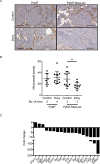PyMT-Maclow: A novel, inducible, murine model for determining the role of CD68 positive cells in breast tumor development
- PMID: 29220404
- PMCID: PMC5722323
- DOI: 10.1371/journal.pone.0188591
PyMT-Maclow: A novel, inducible, murine model for determining the role of CD68 positive cells in breast tumor development
Abstract
CD68+ tumor-associated macrophages (TAMs) are pro-tumorigenic, pro-angiogenic and are associated with decreased survival rates in patients with cancer, including breast cancer. Non-specific models of macrophage ablation reduce the number of TAMs and limit the development of mammary tumors. However, the lack of specificity and side effects associated with these models compromise their reliability. We hypothesized that specific and controlled macrophage depletion would provide precise data on the effects of reducing TAM numbers on tumor development. In this study, the MacLow mouse model of doxycycline-inducible and selective CD68+ macrophage depletion was crossed with the murine mammary tumor virus (MMTV)-Polyoma virus middle T antigen (PyMT) mouse model of spontaneous ductal breast adenocarcinoma to generate the PyMT-MacLow line. In doxycycline-treated PyMT-MacLow mice, macrophage numbers were decreased in areas surrounding tumors by 43%. Reducing the number of macrophages by this level delayed tumor progression, generated less proliferative tumors, decreased the vascularization of carcinomas and down-regulated the expression of many pro-angiogenic genes. These results demonstrate that depleting CD68+ macrophages in an inducible and selective manner delays the development of mammary tumors and that the PyMT-MacLow model is a useful and unique tool for studying the role of TAMs in breast cancer.
Conflict of interest statement
Figures




Similar articles
-
Altered Macrophage Polarization Induces Experimental Pulmonary Hypertension and Is Observed in Patients With Pulmonary Arterial Hypertension.Arterioscler Thromb Vasc Biol. 2021 Jan;41(1):430-445. doi: 10.1161/ATVBAHA.120.314639. Epub 2020 Nov 5. Arterioscler Thromb Vasc Biol. 2021. PMID: 33147993 Free PMC article.
-
SerpinB2 deficiency is associated with delayed mammary tumor development and decreased pro-tumorigenic macrophage polarization.BMC Cancer. 2024 Jul 3;24(1):792. doi: 10.1186/s12885-024-12473-6. BMC Cancer. 2024. PMID: 38956496 Free PMC article.
-
Cell type-dependent pathogenic functions of overexpressed human cathepsin B in murine breast cancer progression.Oncogene. 2014 Sep 4;33(36):4474-84. doi: 10.1038/onc.2013.395. Epub 2013 Sep 30. Oncogene. 2014. PMID: 24077280 Free PMC article.
-
Tumor-associated macrophages as potential diagnostic and prognostic biomarkers in breast cancer.Cancer Lett. 2013 May 10;332(1):3-10. doi: 10.1016/j.canlet.2013.01.024. Epub 2013 Jan 21. Cancer Lett. 2013. PMID: 23348699 Review.
-
Heterogeneity and function of macrophages in the breast during homeostasis and cancer.Int Rev Cell Mol Biol. 2022;367:149-182. doi: 10.1016/bs.ircmb.2022.01.002. Epub 2022 Feb 28. Int Rev Cell Mol Biol. 2022. PMID: 35461657 Review.
Cited by
-
Diverse Macrophage Populations Contribute to the Inflammatory Microenvironment in Premalignant Lesions During Localized Invasion.Front Oncol. 2020 Sep 24;10:569985. doi: 10.3389/fonc.2020.569985. eCollection 2020. Front Oncol. 2020. PMID: 33072601 Free PMC article.
-
Strobilanthes crispus elicits anti-tumor immunogenicity in in vitro and in vivo metastatic breast carcinoma.PLoS One. 2022 Aug 16;17(8):e0271203. doi: 10.1371/journal.pone.0271203. eCollection 2022. PLoS One. 2022. PMID: 35972917 Free PMC article.
-
Comparative Profiling of Metastatic 4T1- vs. Non-metastatic Py230-Based Mammary Tumors in an Intraductal Model for Triple-Negative Breast Cancer.Front Immunol. 2019 Dec 17;10:2928. doi: 10.3389/fimmu.2019.02928. eCollection 2019. Front Immunol. 2019. PMID: 31921184 Free PMC article.
-
Breaking through to the Other Side: Microenvironment Contributions to DCIS Initiation and Progression.J Mammary Gland Biol Neoplasia. 2018 Dec;23(4):207-221. doi: 10.1007/s10911-018-9409-z. Epub 2018 Aug 31. J Mammary Gland Biol Neoplasia. 2018. PMID: 30168075 Free PMC article. Review.
-
Tumor-associated macrophages: role in tumorigenesis and immunotherapy implications.J Cancer. 2021 Jan 1;12(1):54-64. doi: 10.7150/jca.49692. eCollection 2021. J Cancer. 2021. PMID: 33391402 Free PMC article. Review.
References
-
- Wynn TA, Chawla A, Pollard JW. Macrophage biology in development, homeostasis and disease. Nature. 2013;496(7446):445–55. doi: 10.1038/nature12034 ; PubMed Central PMCID: PMCPMC3725458. - DOI - PMC - PubMed
-
- Ostuni R, Kratochvill F, Murray PJ, Natoli G. Macrophages and cancer: from mechanisms to therapeutic implications. Trends Immunol. 2015;36(4):229–39. doi: 10.1016/j.it.2015.02.004 . - DOI - PubMed
-
- Ruffell B, Coussens LM. Macrophages and therapeutic resistance in cancer. Cancer Cell. 2015;27(4):462–72. doi: 10.1016/j.ccell.2015.02.015 ; PubMed Central PMCID: PMC4400235. - DOI - PMC - PubMed
-
- Noy R, Pollard JW. Tumor-associated macrophages: from mechanisms to therapy. Immunity. 2014;41(1):49–61. Epub 2014/07/19. doi: 10.1016/j.immuni.2014.06.010 ; PubMed Central PMCID: PMC4137410. - DOI - PMC - PubMed
-
- De Palma M, Lewis CE. Macrophage regulation of tumor responses to anticancer therapies. Cancer Cell. 2013;23(3):277–86. Epub 2013/03/23. doi: 10.1016/j.ccr.2013.02.013 . - DOI - PubMed
MeSH terms
Substances
LinkOut - more resources
Full Text Sources
Other Literature Sources
Medical
Molecular Biology Databases

